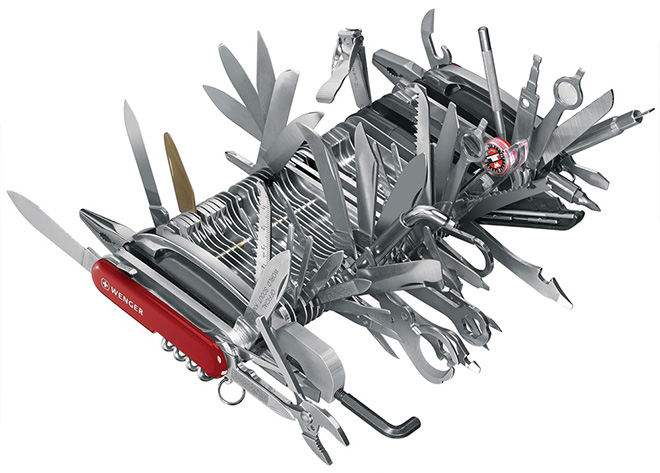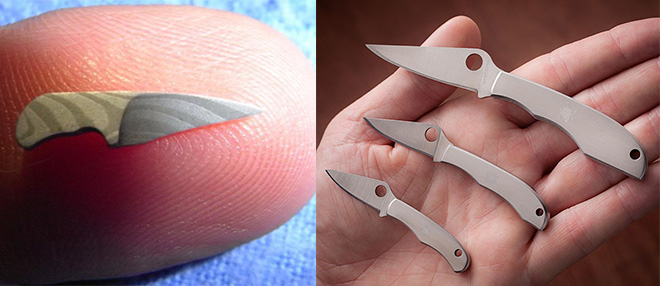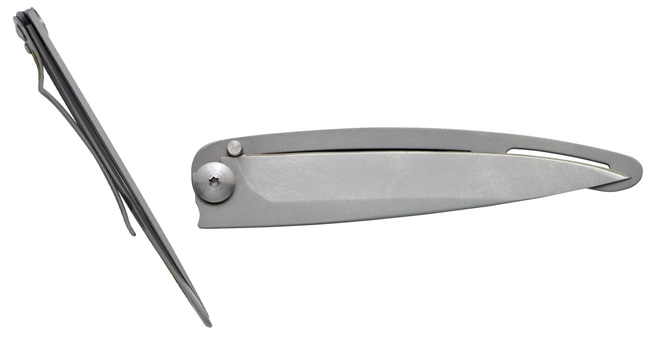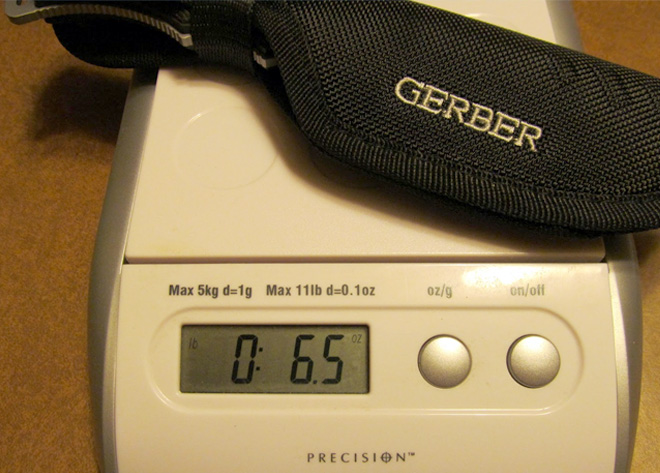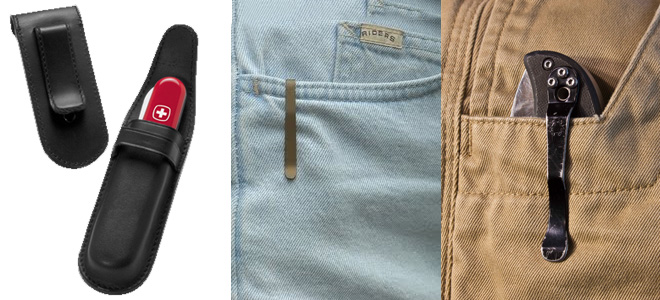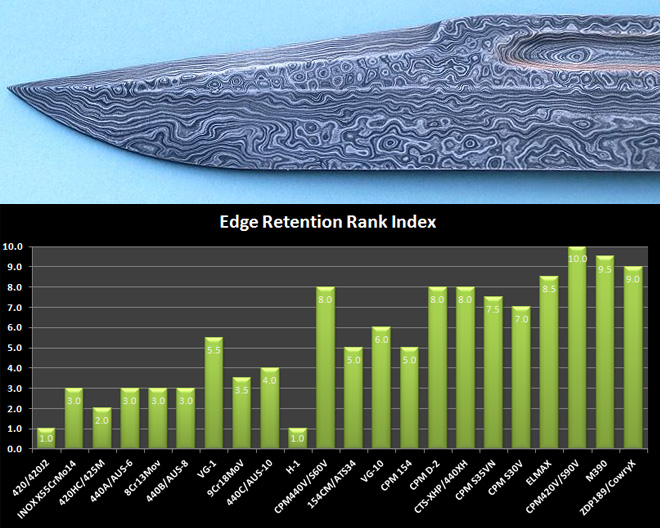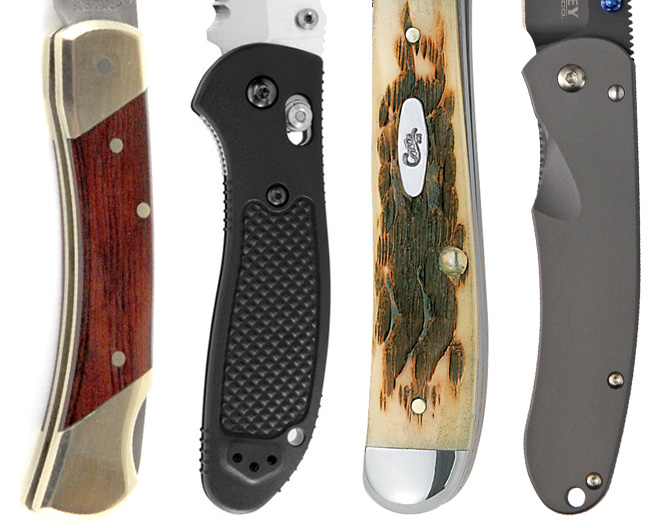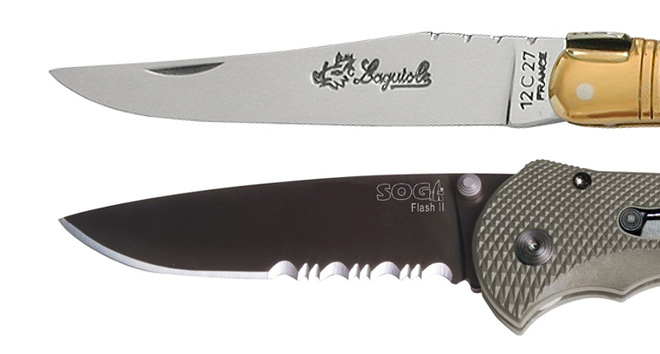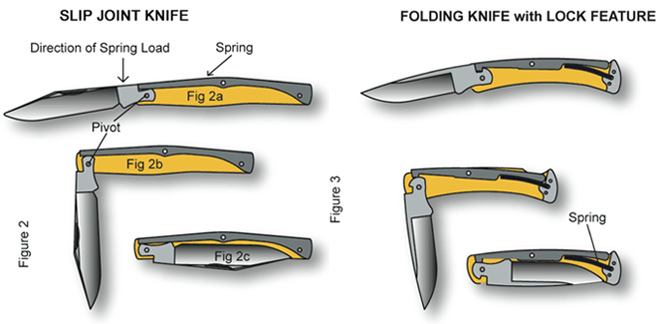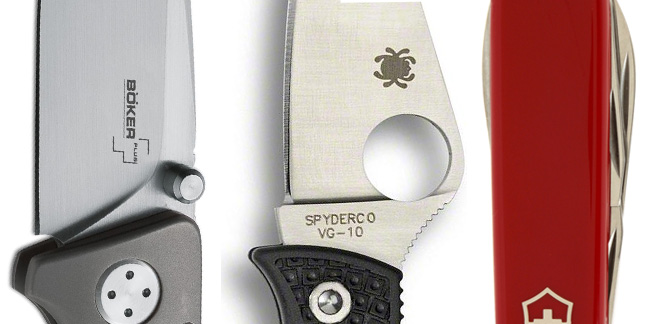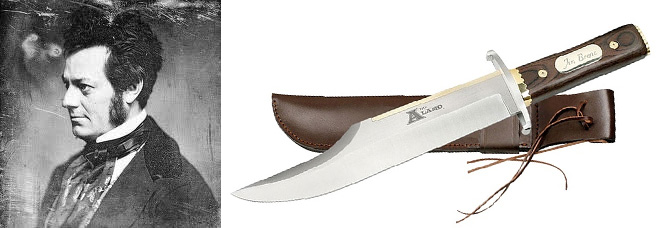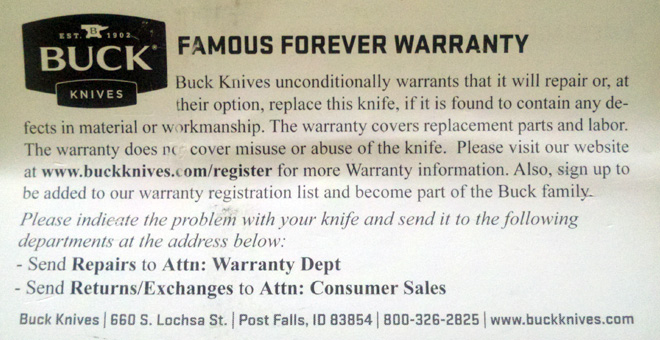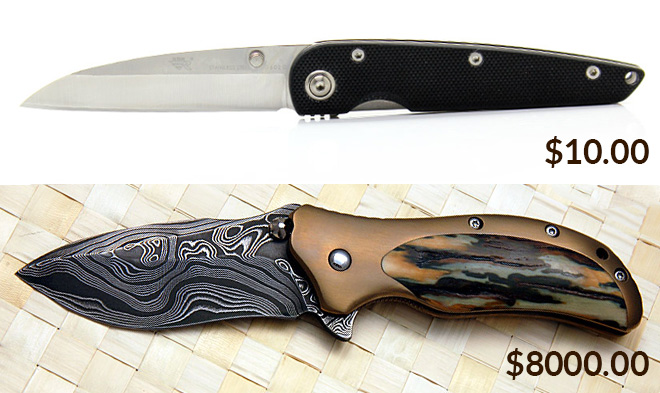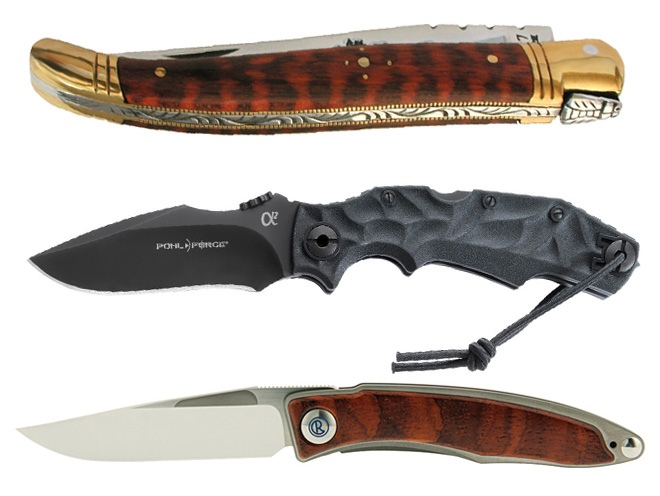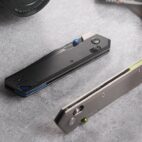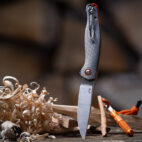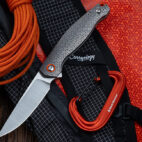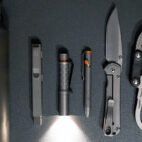EDC Pocket Knives :: Introduction (1 of 2)
Introduction to EDC pocket knives
An everyday carry pocket knife is a tool, not a weapon. Repeat that last sentence to yourself ten times. In fact, a knife (or cutting blade) is the first ever tool made by humans, evidenced by stone versions that are over 2.5 million years old. We had a need back then. Still do today. However, things have changed a bit since that time. Today’s society immediately connects the idea of a knife with a threatening weapon rather than a tool.
For us at Carryology, this isn’t how we define an EDC pocket knife. They should be used like a key, a pen, or a cellphone. Well, not literally. You’re not going to make a long-distance call on your Swiss Army Knife. The purpose is to effectively perform everyday tasks in which a sharp blade is necessary; opening packages or envelopes, cutting strings or tags, and other small chores. There are endless possibilities and they will become apparent once you have convenient access to one. If your job or lifestyle requires you to need a sharp blade more than 10 times a day, you should upgrade to a work knife or multitool, not an EDC pocket knife. Here is a fun blog dedicated to the uses of a pocket knife. Just try not to go overboard…like the old saying goes “if all you have is a hammer, everything looks like a nail”.
Choosing the right one for you can be difficult. So to help narrow down your selection process, let’s take a look at the major different features out there (yes, there are probably hundreds more, but we’re a carry blog…not a knife blog).
Blade length
For an EDC pocket knife, you generally only need a 3″-ish blade. Sometimes a bit shorter, sometimes a bit longer. Any longer and you’re in a different category of knife, any shorter and the knife is more or less useless. Again, let’s focus on small chores and tasks – not sawing down a tree. Take into consideration that there are also some legal issues with longer blades. Some US states allow up to a 5.5″ open blade, others only allow a 2.5″ maximum length, some less. Look up your state laws on knife carry before making a purchase or carrying yours in public. Otherwise, you may need to apply for a concealed carry permit, which isn’t what we’re after here.
Size
The exterior dimensions of the knife when it is in the closed position. We think slimmer is better, especially for pocket carry. But too small and it will get lost in your palm, making it unusable as a tool. The goal is to find a balance that fits your pockets and your hand. Have a ruler handy if you’re looking to pick up a knife online, as the product photos can sometimes be a bit misleading for accurate scale.
Weight
Ideally an everyday carry pocket knife should be lightweight. The difference between a few ounces doesn’t seem like much on paper, but just wait until you’re carrying it in your pocket for 12+ hours daily. It adds up.
Keep in mind, lighter doesn’t always mean better. Aluminium saves weight, but steel is stronger. Titanium is very strong and lightweight, but costs a bit extra. Compare weights of different models and then research the construction or reviews to make sure it can stand up to some daily abuse.
Carry method
Yes, carrying your EDC knife in a pouch on your belt is possible, but we’re not really into that look. Your knife should be kept away, but still readily available. You don’t need to wear it around your neck, advertising it to everyone. If you need a belt pouch for your work knife and job, more power to you. But we’re focusing on an “office type scenario” and business casual, belt-holstered pouches don’t mix. We like pocket clips as well as in-pocket carry options. Depending on the size/colour/finish of the pocket clip, your knife carry still may be pretty visible, but not necessarily sticking out like a sore thumb. Some are more discreet than others, while others leave a considerable amount of the knife visible. With a pocket clip, you can quickly and easily access the knife to perform a small task. In-pocket carry is great for stealthily carrying in a public setting, except you may have to dig around in your pockets for it. The best way to resolve that issue is to carry less in your pockets. Switching between the two carry methods is a great balance, depending on the setting. Find what works best for you.
Blade material
99 times out of 100, you’re going to find steel is best for an everyday carry blade. Titanium sure would be nice for its strength to weight ratio, but it doesn’t keep an edge like steel does. There are a wide array of steels to choose from out there, all slightly varying from one another depending on the element content. Each type of steel has its own benefits and downfalls including corrosion resistance, strength, edge retention, cost, and more. For example, while 30+ layer Damascus steel is great-looking and highly desirable for pocket blades, it is very expensive due to its complex manufacturing. There is no right or wrong steel, but there are some which are certainly better than others. Here is a comprehensive guide on knife steel types for you to get lost in (we warned you). Here is a more basic guide for those who just want to skim the surface.
Handle material
Strength, durability, grip and aesthetics are all part of the decision process for this one. Handles (or “scales” as they’re referred to) range from G10 synthetic grips, rare and exotic rainforest hardwoods, brass, titanium, even animal bone, among countless others. Shown above; wood/brass, G10, animal bone, titanium, respectively. The choice is up to you. We’ve found the knives with organic materials generally look a little less “weapony”, more casual and better suited for non-threatening office carry, which is our aim.
Edge type
The majority of the knife world is pretty much in general consensus that a non-serrated blade is best for everyday carry. Some may disagree, as their everyday tasks may include cutting rope and such. As we noted above, if you’re using a knife in these situations you should likely upgrade to a work knife with a serrated edge, not an EDC pocket knife. A simple sharp blade should be all you need for an EDC pocket knife, allowing you to make clean precise cuts.
Folding blade vs. Fixed blade
You’re not Crocodile Dundee, so you don’t need to EDC a fixed blade. Folding knives are much more compact and easier to carry on your person.
Locking method
Talking about the variety of different locking methods out there is a lot like trying to argue about which American muscle car is the best. They’re all great. Test them out in the store and feel which one you prefer. The basic styles are
- Slip Joint (which don’t lock, like a Swiss Army knife),
- Lock Back (very strong, usually with the visible locker at the rear of the handle),
- Liner Lock (most common, where the tensioned liner pops into place to keep the blade open) and
- Frame Lock (similar to the Liner Lock, except instead of the liner, the frame is the tensioned locking method).
Have a play with them all in your local shop to get a feel of what works best for you. You can get more info here, and here too.
Opening method
Some open fast (like the Thumb Stud), some open really fast (like the Emerson Wave), while others require two hands and time (Nail Nick). It isn’t just about fast deployment here. A few of these methods make the form factor considerably larger, which isn’t ideal in our opinion (like the Spyderco Round Hole), here is a site where you can start your research. We’ve found that the Thumb Stud and the Nail Nick seem to be reliable methods of blade opening, while keeping the profile slim for in-pocket carry. There are plenty others for you to experiment with though.
Company history
If this matters to you, there are some really interesting stories out there. Made in USA, made in France, made in Germany, handmade by artisans, invented or carried by a famous historical figure, etc, etc. We don’t have enough space on all of the internet’s hard drives to cover all these histories. So we’ll let you dig on that. Maybe you’ll identify with one brand and appreciate their specific values.
Warranty
You want to find a knife maker with a solid warranty, as there are some truly amazing ones out there. Unconditional lifetime warranties are pretty easy to find in this product market, so it would almost be stupid not to make a purchase if the product didn’t have one. Though some knives under $20 may not have these awesome warranties, it wouldn’t be an inexpensive replacement fee if anything were to happen.
Price
You guessed it, this one starts from a few bucks up to thousands of dollars. It all depends on what you’re looking for and how upset you’ll be if your investment goes missing/gets lost. Depending on your bank account, you might not be too upset if you lose a $25 knife, but maybe you’re in the $15 club. Though they’ll be pretty heartbroken, others may find the risk of carrying a $300+ pocket knife is a risk which is balanced out by its benefits. Generally speaking, the more you spend, the higher quality you’ll get, as the knife market is extremely cut-throat (bad pun) and competitive in the pricing. But once you get really high up there, you’re paying for exotics and craft. This doesn’t mean you can’t find an incredibly high quality and useful EDC pocket knife for under $50, or even less than $20. In our opinion, sub-$100 blades are our preference (though it is fun to drool over the pricey ones) and we’ve found plenty of nice selections that range from $10 up to $95, our spending comfort zone.
Aesthetics
Function over aesthetics as always. But EDC pocket knives can be like pocket jewelry, while still being entirely functional, let your taste and preference guide you. A non-threatening look will allow your tool to be carried in an office or in a public space without upsetting your sensitive coworkers. But, if you don’t interact with society or simply don’t care about people’s opinion on this, there are plenty of tactical and aggressive-looking designs out there. Though these tactical knives are definitely a visual treat for the eyes with awe-inspiring manufacturing, we prefer the classic/timeless/tasteful look, which is commonly defined as a “gentleman’s EDC pocket knife”.
Stay tuned for our upcoming EDC Pocket Knives :: Road Test (2 of 2).
We’d like to say “Thank you!” (ahead of time) to the brands who partnered up with us on this Road Test, offering up some sharp toys tools for us to review:
Baladeo
Buck Knives
CRKT (Columbia River Knife & Tool)
Laguiole Actiforge
W.R. Case & Sons Cutlery Company





 Carry Awards
Carry Awards Insights
Insights Liking
Liking Projects
Projects Interviews
Interviews
